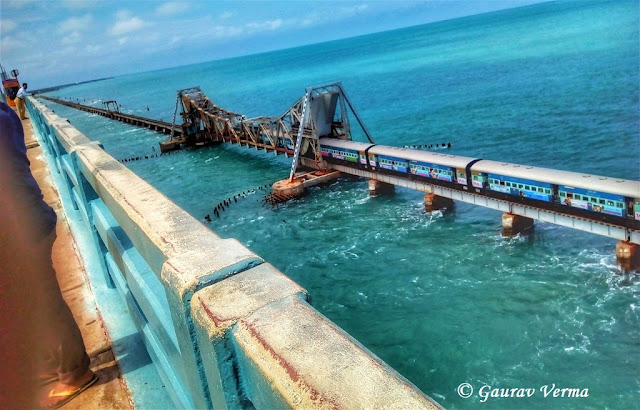It
all seemed like a fantasy at first. It was an auspicious full moon night. Goddess
Parvati, dressed up in all the fineries, was taking the round of the Rameshwaram
temple in a golden palanquin. The accompanying chants, smoke and drum beats added
to the rare spectacle. The following round by Lord Shiva from his sanctum to the
goddess’ almost seemed like a royal routine. And, why not, for, he is the Lord
of the Lord here in Rameshwaram – literally meaning Ram’s god.
When
Lord Ram returned to these shores after slaying Ravan in Lanka, despite being on
the right side, he wanted to repent for the killings. He washed his hair at the
spot now called Jada Teertham before worshipping Shiv. Where Laxman, Ram’s
younger brother, took bath Laxman Teertham. It so happened that Hanuman was
getting late in bringing a lingam from the Himalayas for the worship, so Sita
built one from sand. The lingam in the sanctum of the Ramanathaswamy temple or
the Rameshwaram temple is believed to be the same. And, the 22 tanks and wells in
the temple’s periphery, called teerthams, are said to absolve the sins of human
beings today.
The
sheer process of bathing in their holy water relieved us of a lot of worldly
burdens instantly. The day started with a beautiful sunrise casting amber hues
in the sky and the calm seawater calling you to begin one of the most amazing
experiences.
We took a dip in the Agni Teertham (the sea shore)
before proceeding to the temple precincts for bathing in the 22 teerthams. The
resulting happy state of mind and being added colours and charm to the
magnificent corridors with a never-ending train of columns and colourful
ceilings leading to the sanctum sanctorum.
Before and after the epic
war
The
battle chapter for Ram might have had its beginnings in the forest of
Panchvati, but it was at Gandhamadana Parvatham that it started for real. The
highest point on the island, it is believed to be the same hillock from where Hanuman
jumpstarted his flight to Lanka. The two-tiered temple had imprints of Ram’s
feet on a chakra and gave us a splendid panoramic view of the region. Not far
from the Ramanathaswamy temple is also Satchi Hanuman, where the ardent devotee
brought to Ram the news of having found Goddess Sita and her jewellery
(choodamani) as proof. With that crucial information and an army at standby all
that was needed was planning for the war.
Now enters Vibhishan! With Bay of Bengal on one side and Gulf of Munnar on another,
Kothandaramar Temple was where Ravan’s brother is believed to have met Ram and
sought refuge.
The temple sits on the southernmost tip of the island and was
the only historical structure in the area to have survived the 1964 cyclone. Estimated
to be anywhere between 500 and a thousand years old, this where Ram performed
Vibhishan’s ‘pattabhishekam’ (ceremony marking his ascend to the throne of
Lanka) after the Ravan was killed and the battle was over. Story in pictures:
Further down the
scenic road, to assure Lanka’s safety, Ram broke the bridge that was built to
reach Ravan’s kingdom with his bow, the place hence called – Dhanushkodi.
Sometime
on their way back to Ayodhya, Sita felt thirsty. To quench her thirst, Ram
dipped his bow into the seawater and shot an arrow into earth from where a
stream of sweet water emerged which continues to be so at Villoondi Teertham.
Quick
tips:
1. Most of the
temples in Rameshwaram do not allow photography and it is followed very
strictly.
2. The weather
changes from pleasant to scorching in a matter of few minutes, so be prepared.
3. Do not forget to
check the various puja and special timings with the Ramanathaswamy temple
administration for once-in-a-lifetime experiences.
Other spots to see:
Ruins
of Dhanushkodi: The place still remains largely uninhabited since 1964. The
reminders of that cyclone are everywhere, like the dilapidated railway station
and the carcass of this church.
Pamban Rail bridge: Connecting Rameshwaram to mainland India, it was the longest sea
bridge for almost a century. The double-leaf bascule section of the 2km+ long
bridge is raised to let the ships pass through is still the star presence.
APJ
Abdul Kalam memorial: Taking architectural inspiration from various national
landmarks and built in yellow stone, the memorial is built on the resting spot of
Dr. Kalam, with its four halls a walk through his life and achievements.










Very good post. Highly informative for travellers who want to visit Rameshwaram in Tamil Nadu. Nicely written. Keep up the good work.
ReplyDeleteThank you Cedric for dropping by. Glad that you liked the post.
Delete